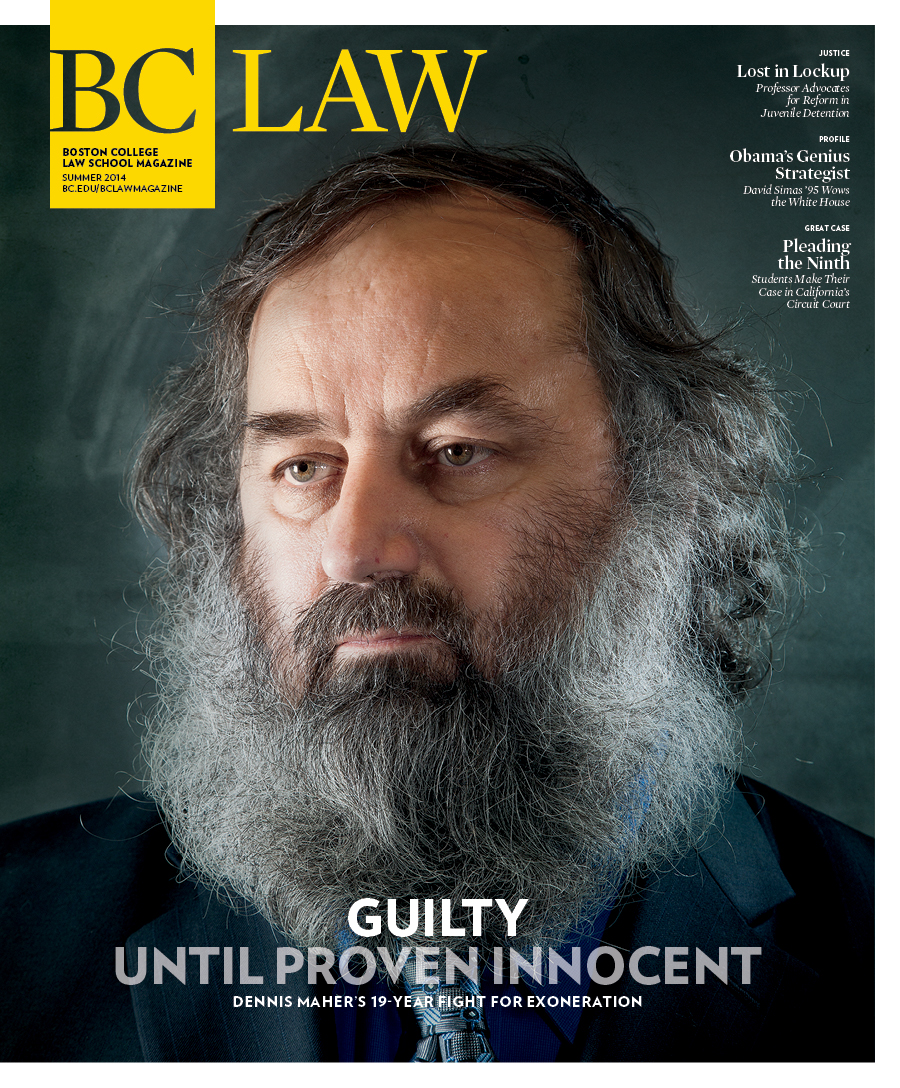‘Good morning. May it please the court. My name is Marija Ozolins. My partner Mackenzie Houck and I are certified law students participating in the Boston College Law School Ninth Circuit Appellate Project. We are appearing under the supervision of Professor Kari Hong who is seated at the counsel table. We represent petitioner Rita Maria Carrion Garcia, whom we will refer to as Ms. Carrion.” So began the oral argument of Ozolins 14’, before a three-judge panel of the Ninth Circuit Court of Appeals sitting in San Francisco on March 11, 2014.
So began the oral argument of Ozolins ’14, before a three-judge panel of the Ninth Circuit Court of Appeals sitting in San Francisco on March 11, 2014.
To be clear: This was not an educational moot court program being indulged by the Ninth Circuit. This was the real thing, with a real client who had fled her native Dominican Republic as a refugee of terrifying domestic violence and, in the course of seeking safe haven, got entangled in the US immigration system and was imprisoned in an Arizona detention center. Ms. Carrion was seeking to stay and work in the US under the status “withholding of removal” and under the Convention against Torture (CAT) Treaty.
Ms. Carrion’s case was a particularly tough one for her young lawyers. Her credibility was in question because the record showed that she had lied to authorities, including to a district court judge, on a number of occasions. The judges saw the weaknesses in Ms. Carrion’s case, and even though her lawyers were two third-year law students, they didn’t hold back.
Take, for example, this exchange. Ozolins is arguing that the Board of Immigration Appeals (BIA) erred in denying Ms. Carrion’s CAT claim. A skeptical Judge M. Margaret McKeown stops Ozolins to say that the BIA had no credible evidence upon which to grant relief. Ozolins responds:
Ozolins: “We would argue that there is substantial evidence that compels reversing the BIA decision on the CAT claim as well…”
Judge McKeown: “What.”
Ozolins: “On the torture issue under CAT we have a police report, two witness affidavits, Ms. Carrion’s reasonable-fear interview, and her application for a withholding of removal which compel holding that she had been raped, beaten,…
Judge McKeown: “No, but she has an adverse credibility finding so we don’t have all of that. Her credibility underlies all of those things, doesn’t it?”
Ozolins: “No, your honor, the police report is submitted by her mother, the two witness affidavits…”
Judge McKeown: “Based on what she told her mother.”
Ozolins: “Your honor…”
Judge McKeown: “Yes or no?”
Ozolins: “No, your honor. The police report was based on the mother’s continued harassment by Ms. Carrion’s abuser who continually visited her home and threatened her daughter with death if she ever returned to the Dominican Republic.”
Questioning like that would have been tough even for an experienced appellate lawyer. That Ozolins held her own is testimony to her intelligence, dedication, and hard work—and also to the tutelage of Assistant Professor Kari Hong, founder of the Law School’s Ninth Circuit Appellate Project (NCAP).
Hong explains what made Ozolins’ exchange with the judge exemplary. “On her feet, Marija identified the one piece of evidence—a police report about the harm facing the mother—that did not have the taint of Ms. Carrion’s statements on it. This was a critical argument because it pointed the court to evidence that the BIA had not considered when dismissing all of the presented evidence,” Hong says. “Marija’s ability to call this up this evidence on the spot was exceptional.”
Hong, who joined the BC Law faculty in the fall of 2012, has a long history with the Ninth Circuit. She clerked for the court after law school, and later had her own private practice specializing in immigration and criminal appeals. She estimates that she’s handled just shy of 100 appeals before the Ninth Circuit.
With a geographic area that includes California and Arizona, the court has an extensive immigration docket. Hong knew that the court had a program that permits law students, pro bono and under supervision, to handle a small number of immigration appeals hand-picked by the court from among thousands of cases. The court schedules the briefing and oral arguments to coincide with the academic calendar. The program helps the court with its docket, provides legal representation to people in serious need, and offers a singular educational opportunity to law students.
“For an attorney to have one appellate argument during his or her entire career is a pretty remarkable achievement,” Hong says. “The Ninth Circuit allows law students to have that opportunity.”
Coincidental to Hong joining the BC Law faculty, Dean Vincent Rougeau appointed Clinical Professor of Law Paul Tremblay as Faculty Director of Experiential Learning. It’s Tremblay’s job to coordinate and expand clinical and experiential opportunities for students. Hong approached Tremblay about the possibility of involving BC Law students in the Ninth Circuit program. Tremblay enthusiastically endorsed the idea.
“It was a chance for the students to get involved in some really hard, interesting, challenging legal issues on behalf of clients who have dire needs, just incredible needs,” Tremblay says.
The pilot project got under way around May 2013 and continued through to March of 2014, when the students argued their appeals before the court. Hong invited two students to participate, and let them each invite a friend as a partner. Ozolins and Mackenzie Houck ’14 handled Rita Maria Carrion Garcia v. Eric H. Holder, Jr., US Attorney General, and David Kete ’14 and Andrew Mark Trombly ’14 handled Gabriel Jara-Arellano v. Eric Holder, Jr., US Attorney General.
In that case, Mr. Jara, an undocumented immigrant whose parents brought him to the US from Mexico as a minor, had a criminal record. When his probation officer found drugs in his home in 2008, Mr. Jara was given the choice of serving eighteen months in jail or working undercover with the police. He worked undercover successfully for a year and a half, and eventually went undercover for the California Bureau of Narcotic Enforcement, where he helped authorities to arrest twenty to thirty drug traffickers. Some of those arrested were deported to Mexico.
“Professor Hong told us, ‘Your knees will be shaking, you’ll be sweating, you’ll be incredibly nervous. Just get out that first sentence and you’ll be fine’—and she was completely right.”
On June 20, 2008, while Mr. Jara was working for the bureau, police found drugs and a gun during a routine search of his home. He was charged, pleaded guilty, went to prison, and then on April 24, 2010, was deported to Mexico.
In Mexico, while attending a religious festival in December of 2010, Mr. Jara was recognized by a member of the Zetas gang whom Mr. Jara had assisted police in capturing for drug trafficking when he was an undercover agent in the US. The Zetas gang, composed of current and former police officers, is a violent group of drug smugglers that operates with the tacit approval of the Mexican government. The gang member and several of his associates later attacked Mr. Jara and shot him nine times, leaving him on the brink of death.
Mr. Jara eventually recovered, but is now confined to a wheelchair and suffers debilitating headaches.
While he remained in Mexico, the gang continued to threaten him, and the police did not protect him. On July 7, 2011, Mr. Jara fled to the US, arriving at the port-of-entry at San Ysidro, California, without documentation, expressed to authorities a fear of persecution in Mexico, and was immediately detained.
On November 5, 2012, Mr. Jara’s petition for asylum, withholding of removal, and CAT relief were denied by the Board of Immigration Appeals on the grounds that (1) Mr. Jara had not proven that he was likely to be tortured in Mexico with the acquiescence of government authorities, and (2) at least one of Mr. Jara’s convictions was for a particularly serious crime—either possession of a controlled substance or being a felon in possession of a firearm. At the time of the appeal to the Ninth Circuit, Mr. Jara was still in detention at a San Diego prison.
In Ninth Circuit briefs, Kete and Trombly argued that the BIA’s rulings were in error, and asked for remand. Their briefs cover all the expected and necessary bases, and also, unusually, a creative argument of constitutional law. “Under the Fifth Amendment to the US Constitution,” Kete and Trombly wrote, “the federal government assumes a duty to protect a person when either a federal or state government creates a special relationship with that person or when a government agent ‘affirmatively places that person in danger.’” As an undercover police informant, the students argued, Mr. Jara is entitled to federal protection—and therefore should not be returned to Mexico, where his life was in danger.
“This was different and unique and not something that I often see in immigration briefs,” says Mary Holper, director of BC Law’s Immigration Clinic, who served as a moot court judge for NCAP. Interestingly, she attributes Kete and Trombly’s ability to “think outside the box” to their lack of familiarity with immigration law. “They brought fresh eyes to the case,” she says.
With those same fresh eyes, Kete and Trombly raised another argument not usually invoked in immigration cases. The BIA had disqualified Mr. Jara for asylum because he had committed a “particularly serious crime”—but didn’t explain its reasoning, relying instead on the fact that Mr. Jara and the government had so stipulated. Relying on a new Supreme Court case (Descamps v. US, 2013) Kete and Trombly argued that the stipulation in this case raised a question of law and was therefore reviewable by the court.
Kete was the first of the four students to argue to the three-judge panel in March, presenting the opening statement in the Jara case (see sidebar). “Professor Hong told us, ‘Your knees will be shaking, you’ll be sweating, you’ll be incredibly nervous. Just get out that first sentence and you’ll be fine’—and she was completely right,” he says. For Kete, an aspiring prosecutor, one important take-away from the case was a deeper appreciation for the immigration consequences of criminal convictions.
Trombly describes the awe inspired by the grand, ornate, 100-year-old courthouse. “Being in a building like that, with the columns and the frescoes and the murals and the grand chandeliers, and being able to participate and not just watch, makes you feel proud to be practicing law and representing a client,” he says.
After Kete gave the opening argument, the government’s lawyer argued next, and then Trombly gave the rebuttal. Choosing which student would give which argument was a strategic decision. The advocates giving the opening statements needed to be nimble enough to go off script, without losing focus, when interrupted by the judges’ questions. The advocates giving the rebuttals to the government’s argument, which they were hearing for the very first time in court, had to improvise with on-the-spot analysis condensed into a two-minute timespan. Based on their practice performances and skill sets, Hong made the final decision as to which student would take on which task before the court.
In rebuttal in Carrion, the case involving domestic violence, Mackenzie Houck cited a string of Ninth Circuit precedents that held that women who are sexual violence victims do not need to disclose their rapes at the first opportunity. But regarding Ms. Carrion, Houck’s client, Judge McKeown noted from the bench, “She didn’t share anything on five occasions.” The judge disputed the applicability of the precedents that Houck had cited: “[Ms. Carrion is] quite distinguished from a number of these other cases where there’s a delay in reporting,” she said.
Houck held her ground. “But in those cases, this court has held that if …the non-citizen gives a strong explanation of why they did not disclose, then they should not be punished for their fear of disclosing that earlier.”
Later, reflecting on the case and how, for the judges, it seemed to hinge on the client’s credibility, Houck said that this was exactly why she wanted to work on it. “[Ms. Carrion] hadn’t done what you’re supposed to do at the US border, to immediately present her claim,” Houck says. “But she still had a valid claim that our system had not looked at just because of how she had acted at the border. I was interested in working on the domestic violence case law, and whether she could recover from not initially disclosing her story.”
The Ninth Circuit issued its decisions in both cases in April. One was a loss for Ms. Carrion. The court saw no reason to reverse the BIA’s adverse credibility finding against her, and found no grounds for her “rehabilitation” as a credible claimant because, the court said, the record contained no independent, eyewitness documentation of domestic violence against her. Carrion resulted in a published opinion, which will provide guidance for future asylum-seekers.
“As experienced immigration advocates, Mackenzie and Marija intentionally chose a difficult case with challenging issues. I am proud that they did not select a case that would have been an easy win,” says Hong. “Instead, they learned that sometimes the best we can provide for our clients is a hard fought battle. It is a privilege to represent people with so much at stake. Sometimes, that privilege is paid with heartbreak. As advocates, it is important to learn how to channel the heartbreak into a passion for larger reform. On the immediate level, challenging cases permit lawyers to truly experience the value of and need for giving someone his or her day in court.”
In an unpublished opinion, the Ninth Circuit decided 2-1 to grant Mr. Jara’s petition. The court rejected Kete and Trombly’s constitutional argument, but was persuaded by their argument about the stipulation.
Hong explains: “What is notable about this case is that our client’s first attorney had stipulated that our client’s prior criminal convictions barred him from seeking asylum and withholding. In light of a 2013 Supreme Court case, Descamps v. United States, we believed that such a stipulation was wrong. However, we had the waiver and exhaustion issues to overcome before even contesting the government’s argument that Descamps would reach the same result.
“On their own, Dave and Drew researched, developed, and presented argument that stipulations to the nature of a conviction are legal questions that are not binding on appellate courts,” Hong continues. “Dave and Drew found this concept outside of the immigration context and imported it to this case. The government strongly contested this argument in its brief, the dissenting judge pressed Dave and Drew at oral argument about the contours of their argument, and the dissenting judge’s written dissent strenuously disagreed with this point. It is quite an accomplishment that Dave and Drew identified and developed the nuanced and creative argument that allowed the client to prevail on his case.”
Hong launched NCAP as an add-on to her normal teaching responsibilities but, going forward, she will teach the project as part of her regular course load. “I had not asked for that, but BC is incredibly supportive of this class, so I am very happy that I will have the time to work more with the students to prepare for their arguments,” she says. Next year, Hong will choose four students through an open application process. In recognition of the amount of work the project demands, the clinic will be worth more credits, and from a teaching perspective, Hong says she plans to increase the time that students spend learning how to read and interact with the panel of judges.
On the question of what lessons she hopes to impart to her students, Hong says, “I think one of the most important things I can do is to communicate how important and valuable the practice of law is. I’m a lawyer who always loved practicing and, as a solo practitioner, I never had a bad day. That message is not communicated widely in the public and I don’t think it’s widely communicated to law students. If nothing else, I want to let people know that there’s a path that they can find to have a wonderful career.”
Contributing writer Jeri Zeder can be reached at jzbclaw@rede.zpato.net.






